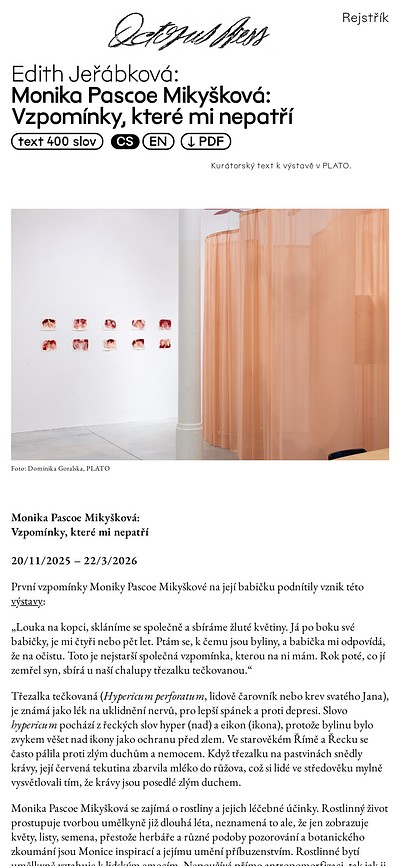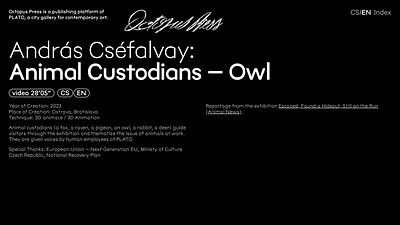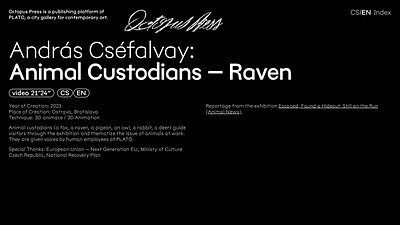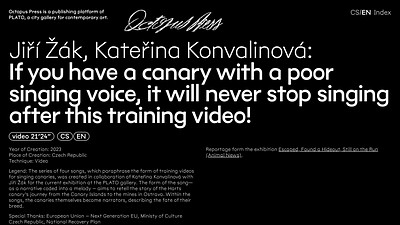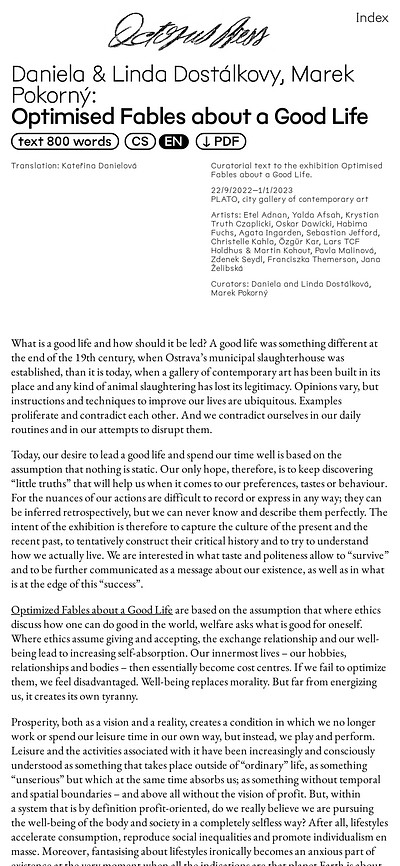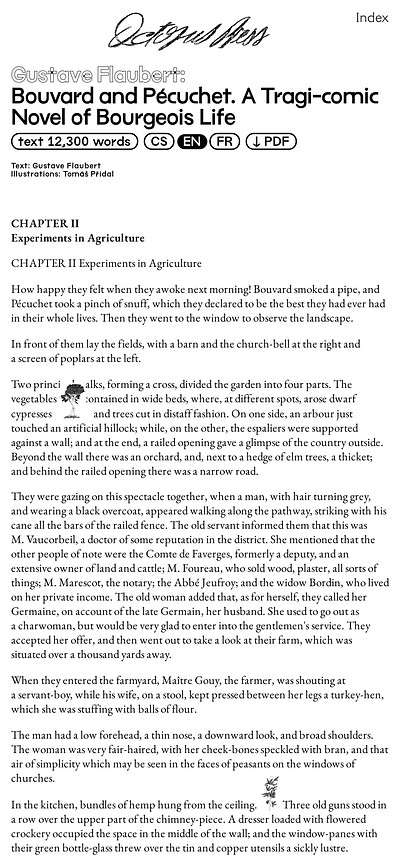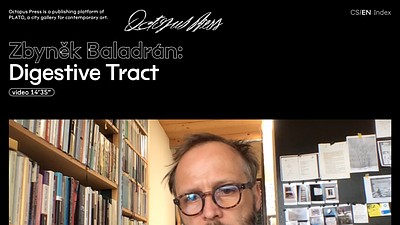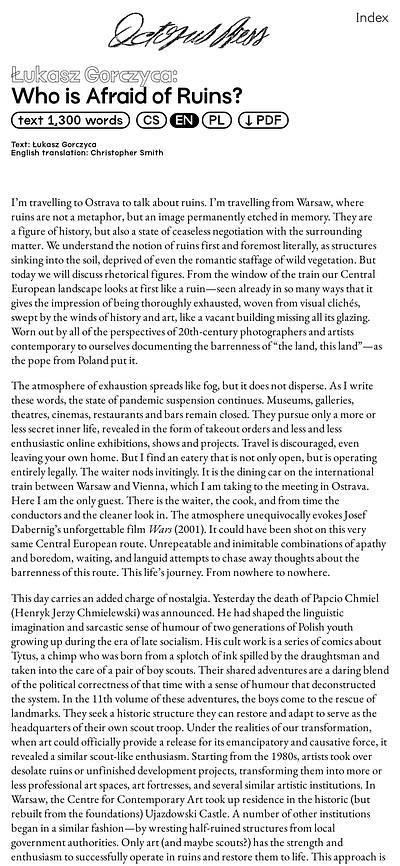Oh and Hah, Beauty, Ruin and Slack
An exhibition cycle in which the transformations of society are identified through the image and notion of a ruins. It was realised in five parts – “theatre scenes”, and the Octopus Press publishing house.
Ⅴ.
The method of investigation consists of a detailed research and subsequent reinterpretation of the context, or tacitly accepted facts that were not originally given special importance. It is also an active reconstruction of an event or phenomenon that took place in the past. It is therefore a way of retrospective knowledge based on the evidence and information obtained so far, which is common to archaeology, the detective novel and critical analysis.
As an analyst, archaeologist and investigator, the French curator Pierre Bal-Blanc, in collaboration with a number of artists, has decided to explore and critically activate the legacy of the prematurely deceased American artist-anarchist Christopher D’Arcangelo.
Ⅳ.
What happens to a ruin when it is translated into different aesthetic canons?
What is the relationship between the ruin and its representation, what represents it and how? How useful and harmful are representations of ruins? Does the representation multiply the ruin’s entropy or does the ruin acquire a new (and significant) integrity in the image? Through emotional identification with it, it offers the possibility of transition, of continuation.
The image of a ruin – if it is not a mere document – is an exorcism, a new construction. Does the ruin sweep all other themes into the abyss of time? The image of a smouldering ruin wishes to hang on the wall for a long time, being caught in peripheral vision while meandering along the online stream of images of the present, and to create a new identity that is difficult to simply capture. It takes many images to illuminate it.
Ⅲ.
The ruin that diversifies settles right in our bodies. It is an important indicator of how interconnected we are.
Today, diversity is the answer to the great failure of monocultures, and the pressure for diversification is supposed to solve all our problems. We are asking, however, what about our integrity within the concept of diversity, how new kinships will form independent of gender, sex, race, species, class, party, citizenship, minorities, religions. Are new communities without fixed ideologies sustainable?
Ⅱ.
Mourning should be associated not only with environmental grief, it concerns the whole way society works. Mourning is a purifying process during which we learn to live together with the past and seek meaningful continuations in the future.
Mourning is a shared emotional act that has brought various historical institutions and individuals opportunities to cope with loss and change, and facilitated the collective and individual transition to other temporal, geographical, and social strata. The current proposals to restore this ritual in our highly pragmatic and technologically dependent life attempt to use the formats of institutional reflection and sharing. At the time when its relocation is moving it to a permanent venue burdened with the past, PLATO raises a claim for space and time to observe this situation. The act of mourning is a farewell as well as a collective re-experience, which could also be well applied in the processes connected with the city and the stigmatizing industrial DNA of Ostrava.
Ⅰ.
The first scene, “Metamorphosis”, explores the places where exchanges and cracks occur between the old and the new.
We are interested in the industrial ruins of the city of Ostrava, both the post-revolutionary and the contemporary ones. Is it possible to relate the American phenomenon of ruin porn to the situation in Ostrava? This tourist zombie offshoot turns the life in city centres into entertainment industry and the residents into indigenous objects. What other ruins are produced by the present city for the well-being of its inhabitants? What is the contribution of its institutions, including cultural ones to this production? In what ruin resides the nomadic institution PLATO, which will soon settle in the brick ruin of the former municipal slaughterhouse? What will PLATO transform into and what will become of its current venue, the Bauhaus hobby centre? Its ruin has provided a generous space for contemporary art that has lately been escaping from the white cubes of galleries and entering ruins of various types, from architecture to nature – which knows perfectly how to include the ruins into itself.
Octopus Press is a publishig platform of PLATO, a city gallery for contemporary art.
We initiate the creation and presentation of new texts, lectures, discussions, multimedia essays, reports, chronicle, and works of art and other visual materials that broaden the context of PLATO’s exhibitions and programme.
Octopus Press
Founded: May 2021
Conceived by: Daniela and Linda Dostálková
Editors: Daniela and Linda Dostálková, Edith Jeřábková, Marek Pokorný
Octopus Press logotype: Josse Pyl
Website: Tomáš Celizna
Production: Lenka Škutová
Between 1974–1976, Octopus Press was a legendary alternative bookstore and publishing house in Athens that hosted collective art experiments, activist manifestations, thinking and meetings. Its founders, Teos Romvos and Chara Pelekanou (the two of them were the main protagonists of the Trypa exhibition presented in PLATO Ostrava at the end of 2020), shaped the Greek underground and were among the pioneers of social ecology in the country. PLATO resumes and continues – with the permission of its founders – the activities of the Athenian publishing house, known as “a place where strange ideas originate and proliferate”.
- Language
- Type
- Palate Cleanser2025
- cs
- en
text- 2,000 words
- Monika Pascoe Mikyšková: Memories that aren’t mine2025
- cs
- en
text- 500 words
- Kino Kosmos under the Cosmic Sun2025
- cs
- en
text- 9,800 words
- Kino Kosmos2025
- cs
- en
text- 3,700 words
- Dorota Jurczak: Pyk, Sciak etc.2025
- cs
- en
text- 1,500 words
- Sprouts2025
- cs
- en
text- 800 words
- Curatorial text for the exhibition by Petr Bosák, Robert Jansa and Adam Macháček2025
- cs
- en
text- 900 words
- Curatorial text for Martin Zetová's exhibition2025
- cs
- en
text- 1,100 words
- Cello & Piano2025
- cs
- en
audio - Primeval Forest, Garden and Wall2024
- cs
- en
- pl
text- 1,100 words
- Interview with Barbora Lungová2024
- cs
audio - Barbora Lungová and the gift of painting2024
- cs
- en
text- 1,400 words
- Julie in the Worlds of Fantasy. Marginalia.2024
- cs
- en
text- 1,600 words
- Pigeon newspaper2024text
- Workbook for children The Shell No. 32024
- cs
- en
text- 200 words
- Zvířecí kustodi – Bee2024
- cs
- en
video- 32’32”
- Animal Custodians – Rabbit2024
- cs
- en
video- 33’18”
- Animal Custodians – Owl2024
- cs
- en
video- 28’05”
- Animal Custodians – Fox2024
- cs
- en
video- 32’05”
- Animal Custodians – Deer2024
- cs
- en
video- 33’45”
- Animal Custodians – Pigeon2023
- cs
- en
video- 32’20”
- Animal Custodians – Raven2023
- cs
- en
video- 21’24”
- If you have a canary with a poor singing voice, it will never stop singing after this training video!2023
- cs
- en
video- 21’24”
- Checking the Stove2023
- cs
- en
video- 5’34”
- 0’40”
- Trust2023
- cs
- en
video- 7’03”
- Is it the flight or the fall what my friend is falling for?2023
- cs
- en
video- 12’08”
- Animal News2023
- cs
- en
text- 1,500 words
- Dan Walwin: Relief2023
- cs
- en
text- 1,000 words
- Ukrainian Culture at the Time of Russian Aggression2023
- cs
- en
text- 100 words
- Freely Accessible Books on the Topic of Ukrainian Culture at the Time of Russian Aggression2023
- cs
- en
text- 500 words
- They Thought We Were Alive and They Run Screaming2023
- cs
- en
text- 1,200 words
- On Renewed Land: Locating Ukrainian Destiny2023
- cs
- en
text- 1,900 words
- I Can Hear the Grass Grow2023
- cs
- en
text- 600 words
- Interview related to the exhibition Optimised Fables about a Good Life2022
- cs
- en
text- 900 words
- Interview related to the exhibition Optimised Fables about a Good Life2022
- cs
- en
text- 900 words
- Interview related to the exhibition Optimised Fables about a Good Life2022
- cs
- en
text- 700 words
- Interview related to the exhibition Optimised Fables about a Good Life2022
- cs
- en
text- 1,700 words
- Interview related to the exhibition Optimised Fables about a Good Life2022
- cs
- en
text- 1,000 words
- Interview related to the exhibition Optimised Fables about a Good Life2022
- cs
- en
text- 1,100 words
- Interview related to the exhibition Optimised Fables about a Good Life2022
- cs
- en
text- 900 words
- Interview related to the exhibition Optimised Fables about a Good Life2022
- cs
- en
text- 1,600 words
- Interview related to the exhibition Optimised Fables about a Good Life2022
- cs
- en
text- 900 words
- Interview related to the exhibition Optimised Fables about a Good Life2022
- cs
- en
text- 1,400 words
- The Night2022
- cs
text- 0 words
- Optimised Fables about a Good Life2022
- cs
- en
text- 800 words
- In the footsteps of the Greek underground II: Longing for deep time2022
- cs
- en
text- 7,200 words
- In the footsteps of the Greek underground I2022
- cs
- en
text- 12,800 words
- Elective Affinities: “Anarchism Without Adjectives”. On the Work of Christopher D’Arcangelo 1975–1979 with Dean Inkster and Pierre Bal-Blanc2022
- cs
- en
video- 58’01”
- Curatorial Control2022
- cs
- en
text- 2,500 words
- Ruins. Reconstruction of the past and construction of the future2022video
- 1h 14’43”
- Long Evening with Octopus Press2022
- cs
audio - Oh and Hah, Beauty, Ruin and Slack2021
- cs
- en
text- 900 words
- Our Living Ruins2021
- cs
- en
- pl
text- 3,100 words
- Troubling Time/s and Ecologies of Nothingness: Re-turning, Re-membering, and Facing the Incalculable2021
- cs
- en
text- 16,400 words
- Re/un/doing the Ruin2021
- cs
- en
text- 2,800 words
- Usableness of the list / Portfolio2021
- cs
- en
audio - Tied to Landscapes2021
- cs
- en
text- 800 words
- Tied to Landscapes2021video
- 9’49”
- A Small Encyclopedia of Improprieties2021video
- 12’18”
- Humans need not apply2021
- cs
- en
text- 900 words
- Poems2021
- cs
- en
text- 200 words
- Carbon Care2021
- cs
- en
text- 1,400 words
- Bouvard and Pécuchet. A Tragi-comic Novel of Bourgeois Life2021
- cs
- en
- fr
text- 12,300 words
- And Again G. F.2021
- cs
- en
text- 700 words
- On The Immortality of Art Institutions2021
- cs
- en
- pl
text- 1,500 words
- Expedition PLATO2021video
- 47’25”
- The Great Transformation. The Political and Economical Origins of Our Time2021
- cs
- en
text- 4,800 words
- Digestive Tract2021video
- 14’35”
- Notre Dame of Ruins2021
- cs
- en
- fr
text- 1,100 words
- Who is Afraid of Ruins?2021
- cs
- en
- pl
text- 1,300 words
- The Ruin2021
- cs
- en
- de
text- 3,000 words
- Zapomínání a infrastruktura2021video
- 13’19”
- Forgetting and infrastructure2021
- cs
- en
text- 2,000 words
- Olympia2021image
- Purification II, 20202021video
- 3’35”
- Purification I, 20202021video
- 1’49”
- Chaos: how to ruin a ‘ruin’ and love a ‘ruin-in-love’, I think2021
- cs
- en
text- 5,400 words
- (Introduction) Chaos: how to ruin a ‘ruin’ and love a ‘ruin-in-love’, I think2021video
- 13’35”


